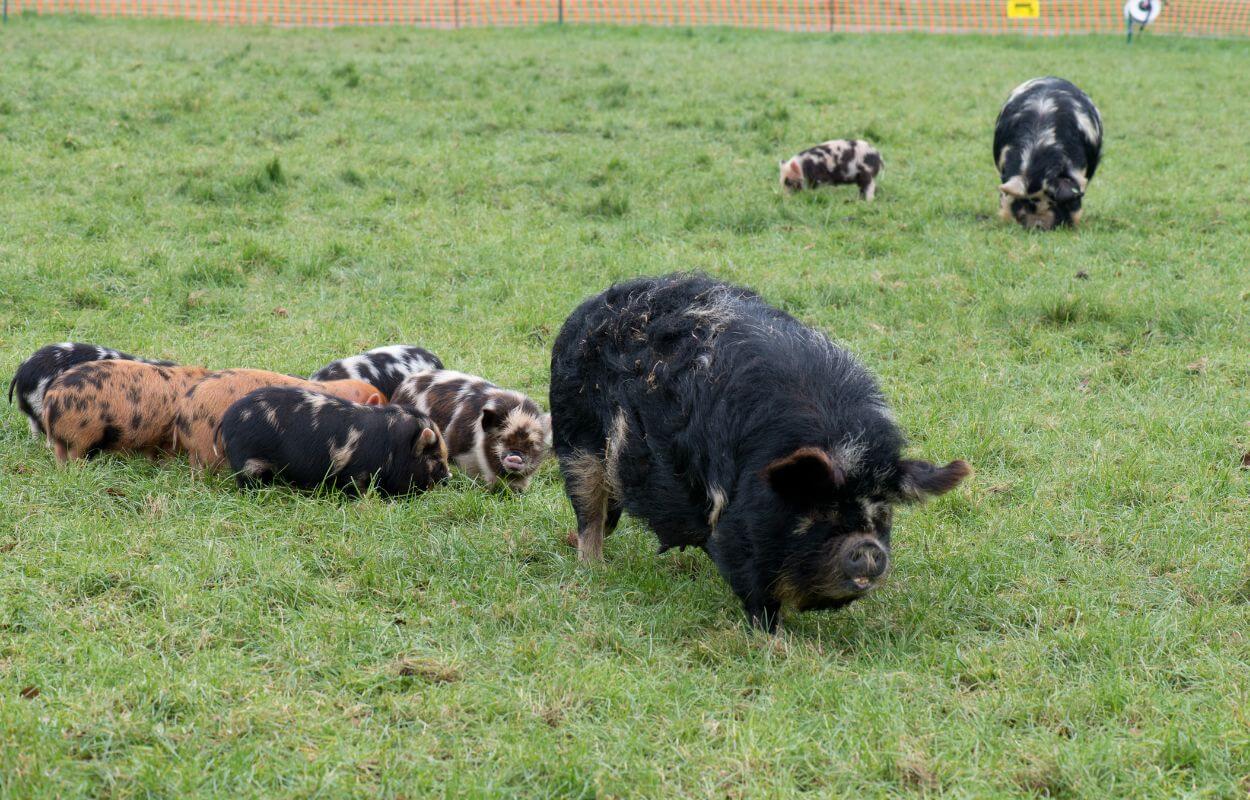
There are many types of pigs, but today I will focus on the miniature ones called Kunekune pigs, which are popular among new farmers. Beginner farmers often choose Kunekune pigs, either as their main breed or as a secondary one.
From conversations with various owners of this breed, I noticed that these farmers often choose Kunekune pigs out of love at first sight, rather than considering factors such as purpose, suitability, or profitability.
So, why do these new pig farmers make this choice? Could it be just because they fell in love with these small pigs due to their size and appearance?
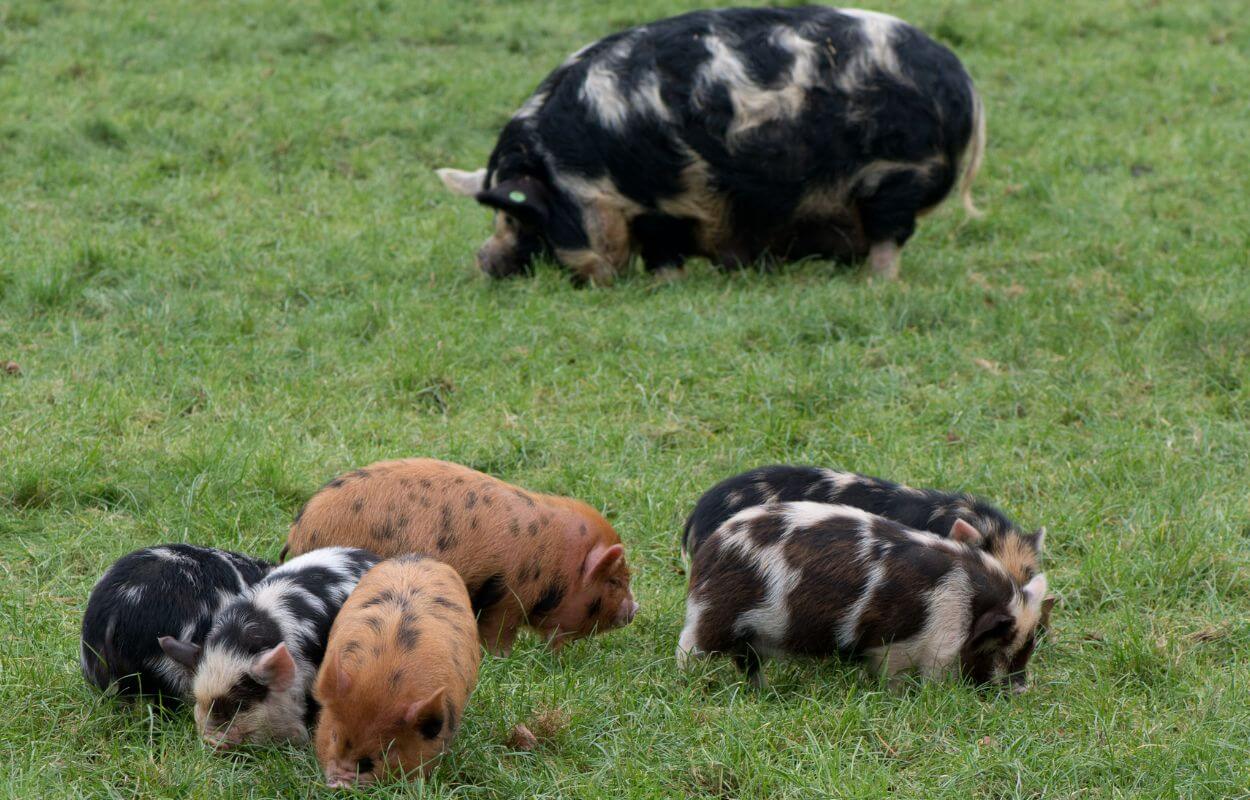
Or is it more than that? Maybe, despite the appearance and general conception, is it really worth raising these pigs on farms or homesteading? Do they have more advantages than disadvantages? Is their growth rate good? Is their meat good to eat?
In this article, I will answer all your questions so that you can make an informed decision about whether or not to raise this breed. The information I provide will also be helpful for those who are interested in buying or keeping this breed as a pet.
Contents
What is a Kunekune pig?
Kunekune is a miniature domestic pig and a rare heritage breed that originated in New Zealand in the early 19th century, where it was primarily raised by people as a food source.
The Kunekune pig is known for its popularity as a pet in countries such as Austria, Belgium, Canada, Denmark, France, Germany, Ireland, the Netherlands, Portugal, Switzerland, the United Kingdom, and the United States.
Good to know: This miniature pig cannot be imported or raised as a pet in Australia for biosecurity reasons.
Kunekune Pig Characteristics
The Kunekune pig stands out among other pig breeds due to its distinct and unique physical characteristics. Let’s see each physical trait of the Kunekune pig individually.
Physical Characteristics
Size
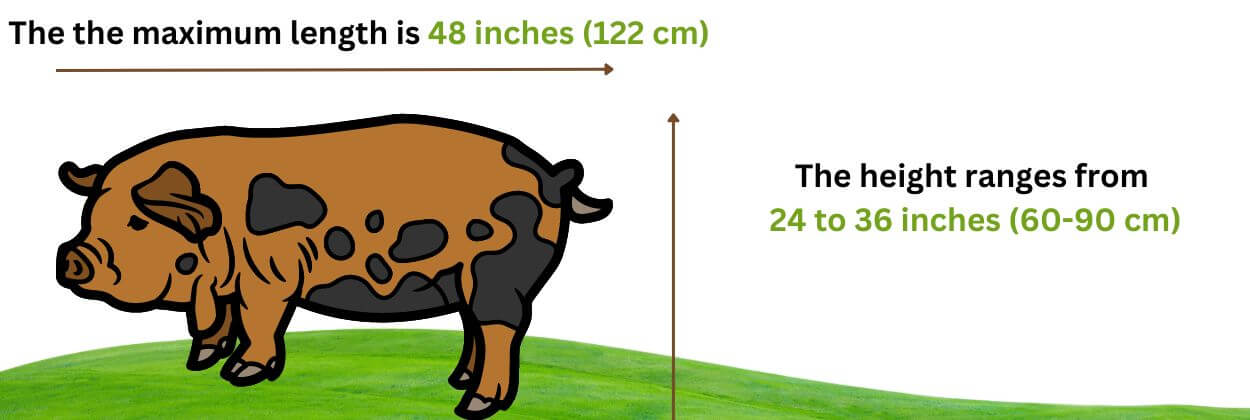
The size of the Kunekune pig can reach a height of 24 to 36 inches (60-90 cm) and a length of 48 inches (122 cm).
Color
Kunekune pig colors can include black, white, brown, ginger, gold, or various combinations of all these. These colors and patterns can vary widely among individual Kunekune pigs, making them visually diverse and appealing.
Body
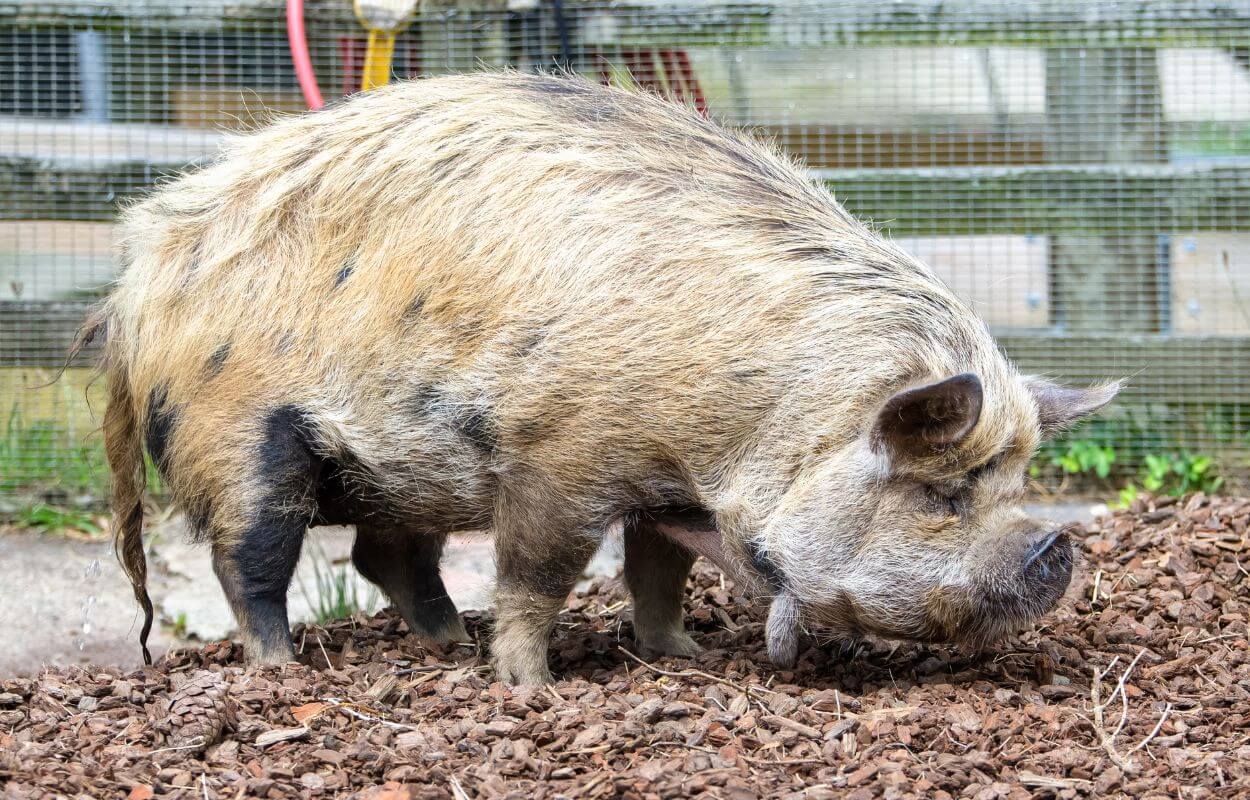
The body of Kunekune pigs is compact and has a distinctively rounded shape, with a prominent belly.
Legs
The legs of Kunekune pigs are long in proportion to their body size. They are well-suited to the rounded body shape and effectively support the pig’s overall weight.
Face
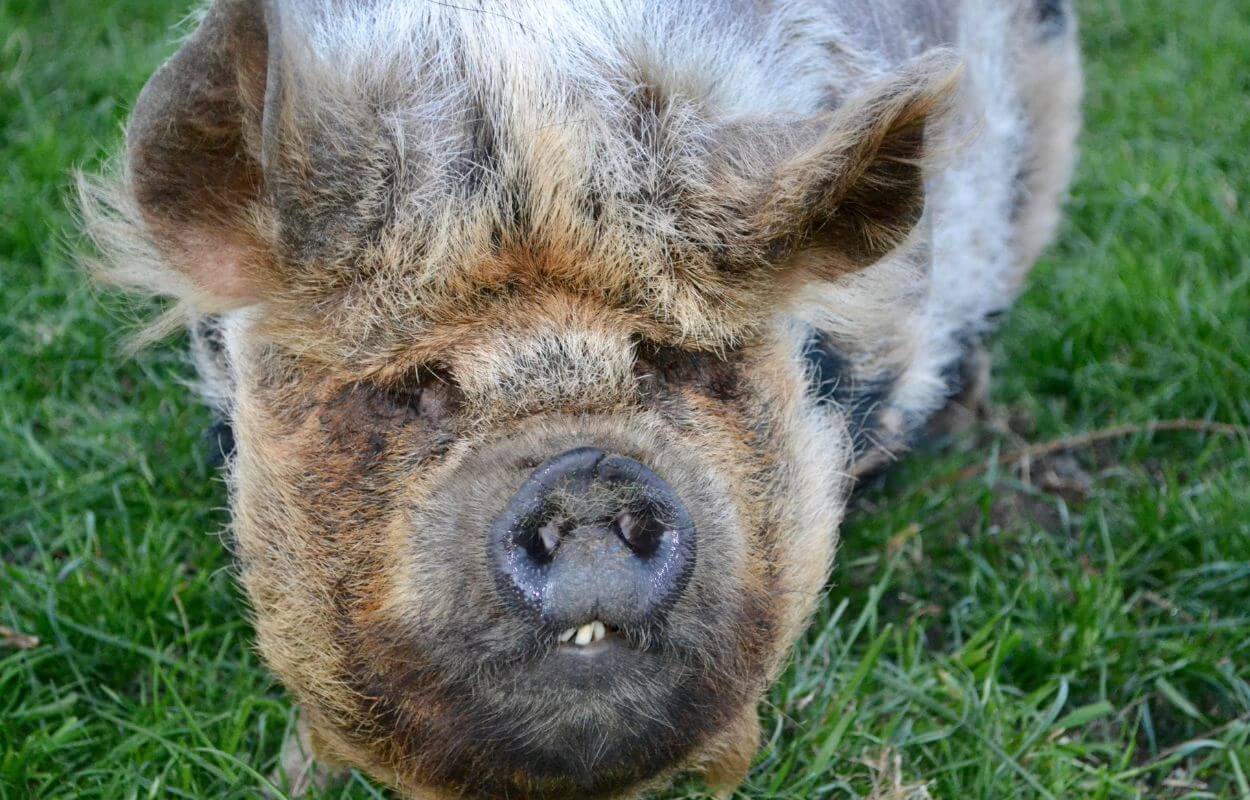
The face of a Kunekune pig is round, featuring two small eyes and a short snout.
Ears
The ears of Kunekune pigs are small and can vary in shape. Some pigs have erect ears, while others may have slightly curved or folded ears. The specific ear shape can vary from pig to pig.
Hooves and claws
They have compact black hooves that provide excellent support for their weight. They need hoof trimming once or twice per year.
Hair
Kunekune pig has long hair that can be also smooth and silky, or curly.
Lifespan
The lifespan of Kunekune pigs is typically 8 to 16 years. This long lifespan places them alongside other heritage pig breeds known for their longevity, such as Mangalica pigs or Red Wattle pigs.
Growth Rate
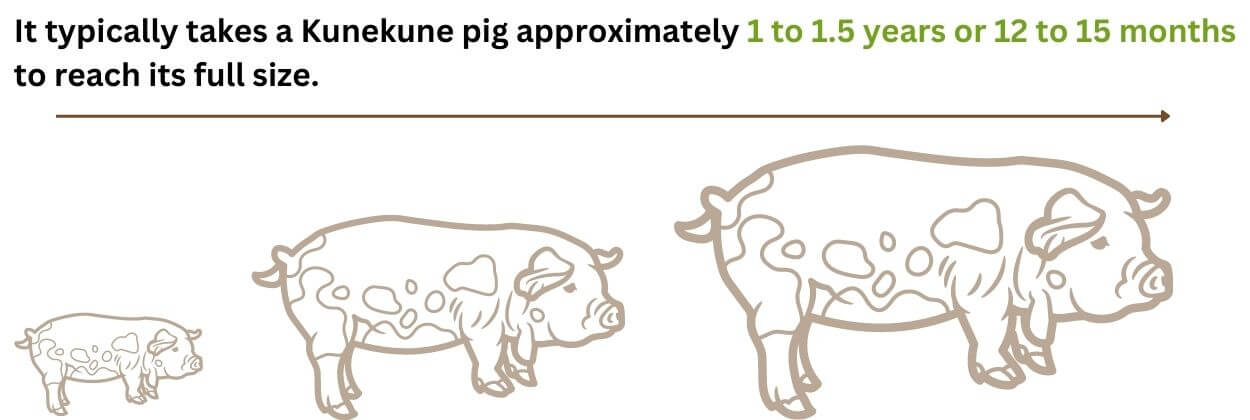
The growth rate of Kunekune pigs is slow, as they tend to grow at a gradual pace, which can be influenced by factors such as genetics and diet.
How fast do Kunekune pigs grow?
Kunekune pigs do not grow fast. It typically takes a Kunekune pig approximately 1 to 1.5 years or 12 to 15 months to reach its full size.
While Kunekune pigs may not reach the size and weight as rapidly as larger pig breeds such as the Idaho Pasture pig, their slower growth rate contributes to the development of their unique characteristics. The extended growth period allows them to accumulate a substantial layer of fat.
Weight
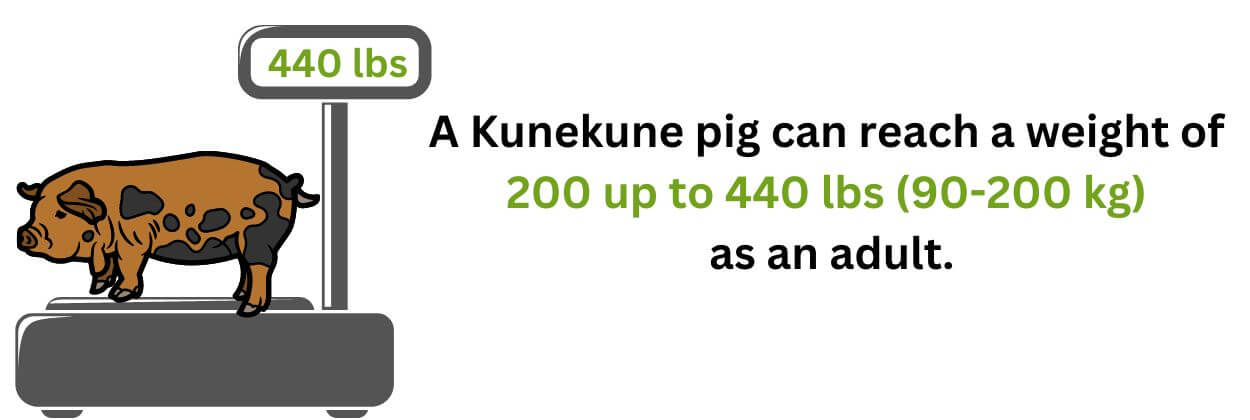
A Kunekune pig can reach a weight of 200 up to 440 lbs (90-200 kg) as an adult.
The weight of females is typically less than that of males. On average, they gain weight at a rate of about 0.5 to 0.7 lbs (0.2 to 0.3 kg) per week during their first year of life.
Slaughter Time
Kunekune pigs can be slaughtered at around 12 to 15 months of age or when they reach a weight of 110 to 150 lbs (50-70kg).
Temperament and Behaviour
Kunekune pigs are known for their friendly, calm, and docile temperament and behavior.
They are incredibly sociable with humans but also with various other animals commonly found on farms, such as ducks, dogs, cats, and chickens. They enjoy being in the company of others and constantly seek interaction.
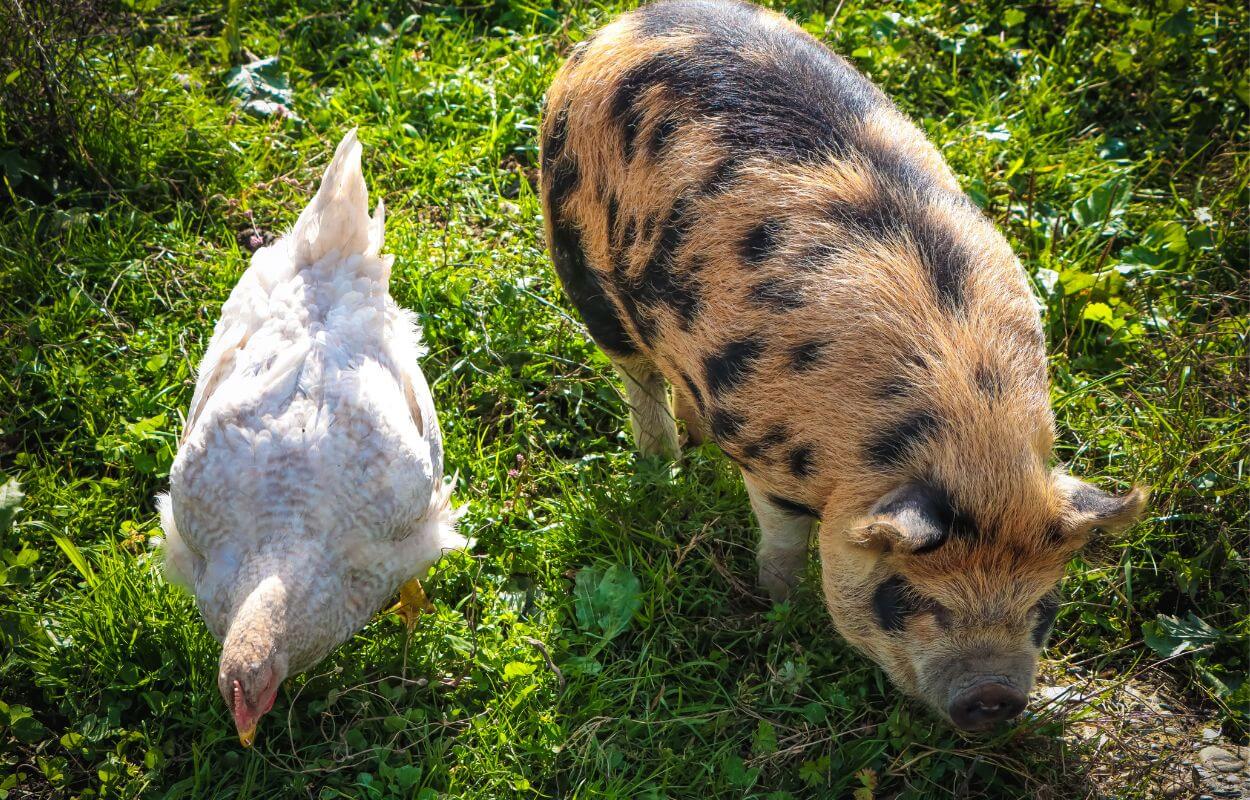
They do not thrive in isolation and benefit from having a companion of their own kind. I would recommend you keep at least two pigs together, as they can live and play.
They have similar behavior as dogs in the company of humans and kids. They love to follow their owners and engage in playful activities.
This pig breed is recognized for its intelligence and can be trained to perform various tricks.
It is important for those who choose to raise these miniature pigs as pets to be mindful of their intelligence and provide suitable mental stimulation. Without it, they may become bored and show destructive behavior in a home environment. Playing games and providing puzzles can help minimize their boredom.
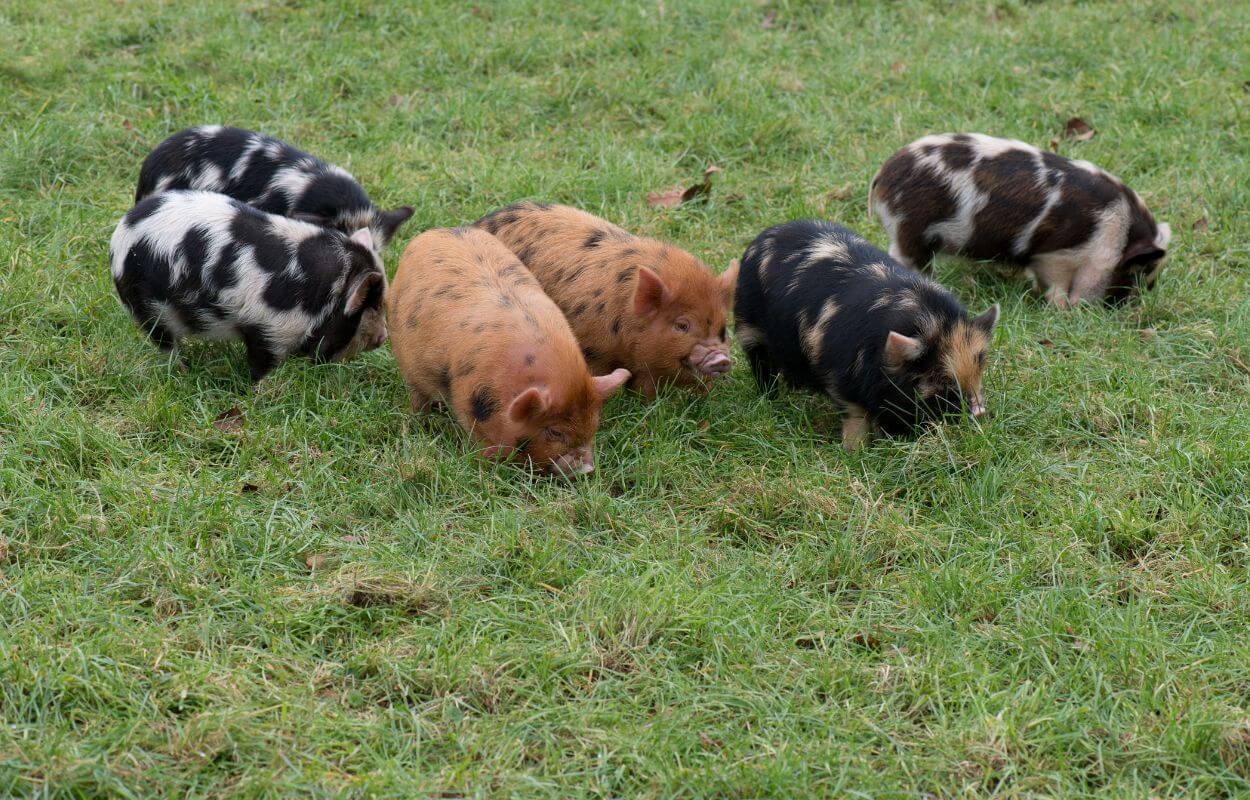
However, despite their friendly and sociable nature, Kunekune pigs are also content with their own company. If the owner is unable to provide constant attention, they are capable of managing their own activities, such as rooting, grazing, and wallowing in mud.
Kunekune pigs have a natural instinct for grazing and a strong affinity for grass. Like other pasture pig breeds, these pigs also engage in rooting and digging behavior, which is instinctual for searching for food and exploring their environment.
Another specific behavior of Kunekune pigs is their vocal nature. They are known to be loud and communicate through various squeals, grunts, and other sounds to express their emotions.
Meat
Yes, Kunekune pigs are good for meat and can be raised specifically for this purpose. These miniature domestic pigs have red marbled meat with a distinctive flavor.
Kunekune pig meat has a great ratio of lean meat to fat, making it desirable for its marbling and tenderness. If allowed to reach a higher fat content, they can also produce a substantial amount of lard. In this regard, Kunekune pigs can be considered lard pigs to a considerable extent.
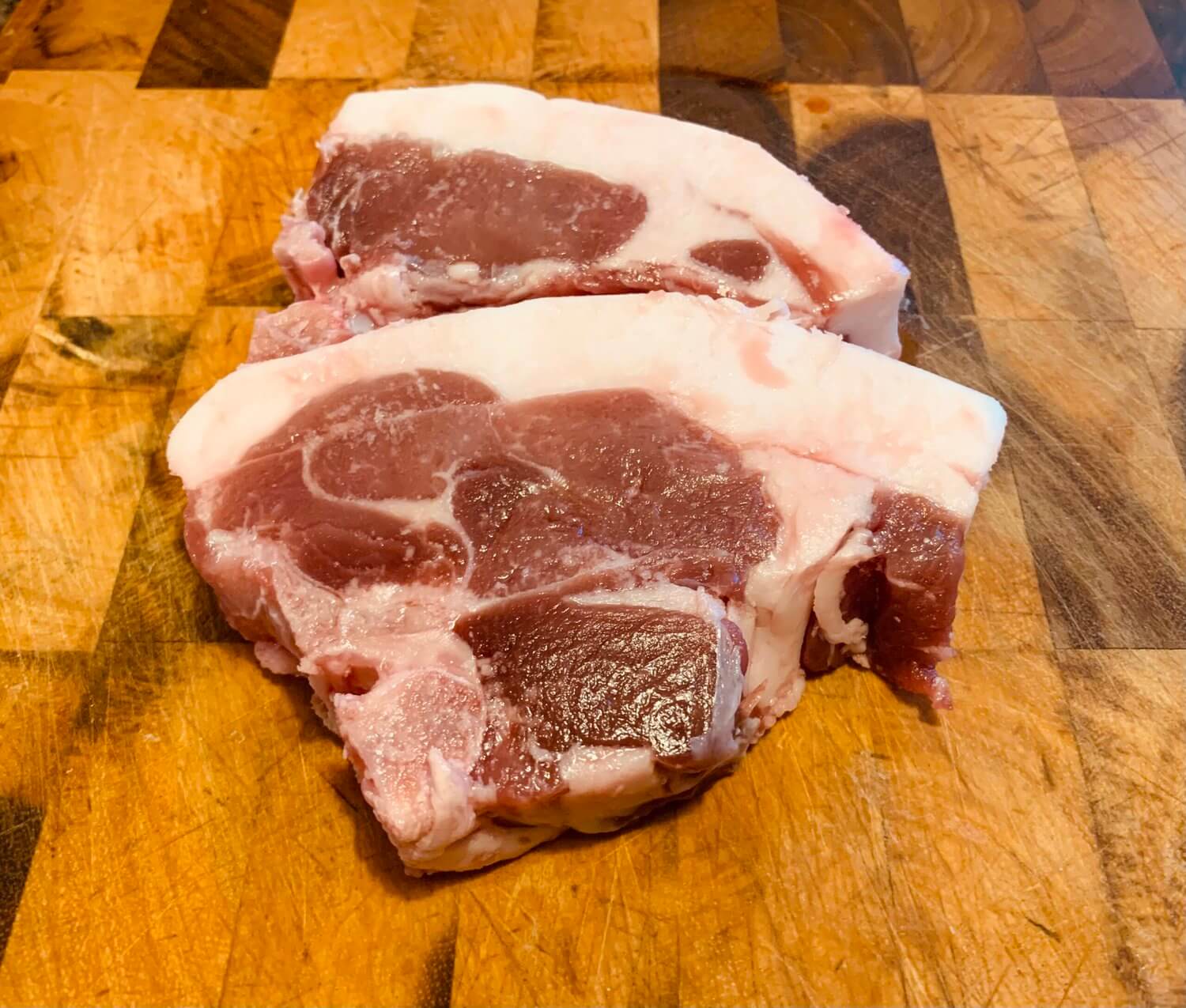
The meat offers a slightly sweet taste, while the fat contributes to its juiciness and desirable texture. It is rich in vitamin D, as well as other vitamins and nutrients beneficial to human beings, especially due to their diet.
It is possible to use the meat of these pigs for various purposes, including bacon production and the creation of homemade meat products such as sausages. Also, the fresh cuts of Kunekune pig meat are well-suited for barbecuing and grilling.
Growing Kunekune Pig
Growing Kunekune pigs is an effortless activity that a homesteader or owner of a small farm can easily undertake. Their low-maintenance nature and independent behavior make them require minimal care, saving the owner’s time and effort.
Feeding
Kunekune pigs can be fed with fruits, vegetables, grass, hay, and grains.
During the warm season, a significant portion of their diet consists of grass. Being natural foragers, they spend a lot of time grazing and rooting, searching for food such as grubs, worms, insects, bugs, and more.
Kunekune pigs thrive on a diet higher in fiber, and you can supplement their feed with kitchen scraps, garden scraps, fruits such as pumpkins, peaches, mulberries, and apples, legumes, nuts like hazelnuts, chestnuts, and acorns, as well as dairy products.
In winter or during seasons with limited vegetation, you can feed Kunekune pigs hay and grains. So, once the vegetation is gone or everything is covered in snow, I would suggest starting to provide them, for example, with hog pellets and alfalfa pellets.
By combining alfalfa pellets with hog pellets, you can decrease the calories they consume and their protein levels. To ensure they stay hydrated, you can always pre-soak their feed a couple of hours before feeding them.
It is essential to make sure they receive enough selenium and an adequate quantity of protein, particularly lysine, to maintain their health. You can add a vitamin and mineral supplement to their daily diet too.
The feeding schedule for a Kunekune pig can follow the usual one used by most farms, which involves splitting their daily amount into two portions, once in the morning and once in the afternoon.
But how much do these pigs eat?
A Kunekune pig of 12 months can consume approximately 1.70 to 2.5 lbs (0.7-1.3 kg) of hog feed, while an adult pig, meaning older than 12 months, can eat up to 1.70 lbs (0.7 kg) of feed daily.
Do not feed Kunekune pigs with tomatoes, potatoes, eggplants, pepper plants, or nightshades. Also, avoid giving them moldy foods, cakes, pastries, or deli meats.
Another important aspect of feeding Kunekune pigs is monitoring the quantity of food they consume. Kunekune pigs have a tendency to gain weight easily, so it is necessary to ensure that they are not overfed.
How much does it cost to feed a Kunekune pig?
It costs approximately $300 to feed a Kunekune pig for 9-12 months, which is lower compared to traditional pig breeds, despite the longer feeding period.
With a daily consumption of 1.7 lbs (0.7 kg), a standard 44 lb (20 kg) feed bag can sustain a Kunekune pig for over 25 days.
Over its lifespan of 9-12 months, a weaner pig will consume around 14.6 bags (643 lbs – 290kg ) until it reaches the weight suitable for slaughter. This cost is based on an approximate price of $22 per feed bag.
Environment
The ideal environments for Kunekune pigs are homesteads or small farms with ample space for them to explore. Systems such as pastures or orchards are excellent options where Kunekune pigs can thrive and maintain good health.
Given their intelligence and curiosity, these pigs require freedom and sufficient space for mental stimulation. This can involve objects for manipulation and designated rooting areas.
Therefore, Kunekune pigs greatly benefit from having access to a spacious outdoor area or pasture where they can freely root and graze. It is important to secure the pigs’ perimeter with an electric fence to ensure their safety.
Climate
Kunekune pigs can adapt to most climatic conditions, making them well-suited for diverse environments.
Shelter
Kunekune pigs need shelter to escape harsh weather conditions, including rain, sun, and wind, ensuring their well-being and comfort.
During the cold season, the shelter provides warmth for the pigs. It is recommended to provide straw bedding in colder temperatures as it helps them stay even warmer and maintain good health.
In the summer, they seek shelter to protect themselves from the sun. They also benefit from having access to a wallow where they can cool off, while the mud helps keep insects at bay.
How many pigs per acre?
You can raise 4 to 6 Kunekune pigs per acre. The actual number may vary depending on the amount of available vegetation.
Breeding Kunekune pigs
Breeding Kunekune pigs involves introducing a boar to the gilt and letting them mate successfully.
Both Kunekune boars and females reach sexual maturity and become fertile at the age of 8 months.
The pick of sexual maturity is fully reached at 12 months of age especially in the case of boar as it develops another set of characteristics such as a thick shield over the shoulder and longer tusks that continue to grow until 18 months of age.
The female even reaches fertility at 8 months of age, it is recommended to wait until she is 10 months of age. She is usually fertile every 18 to 22 days and the heat time window is 8 to 48 hours. When the female is in the heat, you can notice that the vulva is swelling and that her behavior changes too.
The gestation period for Kunekune pigs is 116 days, which is equivalent to 3 months, 3 weeks, and 3 days. After farrowing, the female can be bred again if she is exposed to a boar. If you choose to allow your sows to mate in this manner, you can expect a maximum of 2 liters every 11-12 months. It is important to always check the health of your sow before allowing another pregnancy.
The average litter size for Kunekune pigs is 6 to 8 piglets. Sometimes, the first litter of a sow can be larger, consisting of about 10 to 12 piglets.
Kunekune pigs have excellent mothering skills and often require minimal support during farrowing. The sow takes care of her piglets and produces an ample amount of milk. Just try to be cautious if the sow is larger in size, as she may accidentally crush the piglets by sitting on them.
One piece of advice I have is to feed the sow separately after farrowing. This is because she tends to become very excited when she sees food that could potentially harm the new piglets. It’s great to provide her with a separate space where she can eat without the risk of injuring the piglets.
Kunekune Pig Vaccination
Kunekune pigs need vaccinations to prevent common pig diseases. According to the New Zealand Kunekune Association, Kunekune pigs need the following pig vaccines: Leptospirosis vaccine, Parvovirus vaccine or PPV vaccine, Tetanus vaccine, Erysipelas vaccine, Mycoplasmal vaccine, and E.coli vaccine.
Both Kunekune piglets and adults must follow this vaccination scheme and be re-vaccinated every six months.
Health Issues
Some of the most common health problems in Kunekune pigs are:
- Obesity
- Dental issues – They have a jaw structure that can sometimes lead to insufficient space for teeth growth. This can result in issues such as overgrown or misaligned teeth.
- Skin conditions caused by mange or lice infestation.
- Eye infections due to facial hair that can enter the eyes.
- Respiratory issues, including pneumonia.
Is it worth raising Kunekune pigs?
Profitability
The Kunekune pig breed can be a profitable business, capable of generating a substantial income for a small farm.
You can make money by targeting both the pet market and the meat production market.
Despite their slow growth, you can start selling Kunekune piglets to other farmers, growers, and individuals interested in becoming pet owners.
The price of Kunekune piglets ranges from $650 to $900, which is quite substantial considering the size of the litter.
If a sow has 6 to 8 piglets twice a year, you can earn a minimum of $8,000 up to $14,000 by only selling the piglets. These prices are applicable if you are a registered breeder.
You can also sell boars and gilts to individuals interested in breeding them.
The price for a Kunekune boar and gilt ranges from $800 up to $1,000.
Another option to generate income is by selling the meat to local businesses. The price of Kunekune pig meat is $7 per pound, and it can reach up to $8.5 per pound.
As a personal opinion, I suggest targeting the pet market as it can generate easier profit. Once the piglets are born and reach an age where they no longer rely on the sow, you can sell them without the need to continue caring for them or spending money on feeding them. Those interested in miniature pigs as pets often prefer to buy them at a young age as they are easier to train.
Personal Use
Kunekune pigs are a great choice for homesteaders as well.
Being relatively independent and easy to care for, these pigs are a delight to raise due to their friendly behavior and small size.
You can let them graze and root, and in the end, you will obtain a good amount of red and marbled meat, which is great for steaks and can even be used in homemade products.
A Kunekune pig can produce 80 to 90 lbs (35-40 kg) of meat when slaughtered at a weight of 110 to 120 lbs (50-55 kg). Also, you can obtain lard that can be used for cooking and baking.
Advantages and Disadvantages
Kunekune pigs have their pros and cons, which also depend on the main goals of the grower.
| The advantages are: | The disadvantages are: |
|---|---|
| Great temperament and behavior | Slow growth rate |
| Very easy to manage due to their small size | A small quantity of meat due to their size |
| Good mothering skills | The tendency towards obesity, which can result in a higher fat content than lean meat |
| Substantial litter size | Need for grooming, including trimming |
| They are a hardy pig breed | |
| Market opportunities for both pets and meat |
That’s about it for Kunekune pigs. If you have other questions to which you did not find the answer, please use the comment form below and I will answer you as soon as possible.
If you are looking for other breeds of miniature pigs, you can also read about the Vietnamese Pot-bellied Pig.


